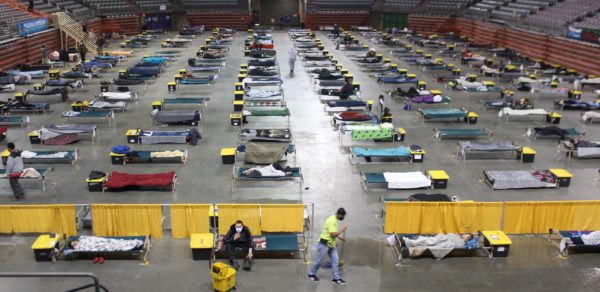
The Anchorage Assembly on Tuesday put an abrupt pause on the Bronson administration’s plans to build a massive homeless shelter.
The move is a major setback for the administration, which was pushing the shelter as a humane and cost-effective option for sheltering the city’s homeless residents this winter. It also leaves open a big question: Where will the 400 people currently sleeping in the Sullivan Arena emergency shelter stay this winter?
Below are the answers to questions about how the shelter proposal was blocked so suddenly, and what’s next for the city. It was adapted from a segment on Alaska News Nightly with additional information added.
What happened at Tuesday’s Assembly meeting?
The Assembly basically declined to put the Bronson administration’s proposal to build the massive shelter on the table. The administration had asked for a $15 million appropriation from the Assembly to start building the shelter. But when the Assembly was getting ready to schedule a public hearing on the bill, it became clear that it just didn’t have the support it needed and the Assembly decided not to vote on it.
The Bronson administration put a lot into this proposal? How did it get killed so suddenly?
The administration made a big push to make this plan palatable to Assembly members of all stripes. For example, they promised there’d be social services on site, that it would be well-designed, and not just a holding-pen to get people off the streets. And they said that financially, it was the most cost-effective way to shelter people, since they could take advantage of economies of scale.
RELATED: Here’s what we know about the new Anchorage mayor’s plan for a massive homeless shelter
One thing that changed before Tuesday’s meeting was the cost. Documents that came out over the weekend showed that the building would cost a lot more than the $15 million proposed. Assembly members said even those new cost estimates were likely to increase substantially. The price tag had even some of Bronson’s ideological allies concerned.
“There were a lot of things that I wanted to support but with the $15 million price tag it was just a hard pill to swallow. And now that we’ve bumped that up to about $22 million, it’s even worse,” said Crystal Kennedy who represents Chugiak and Eagle River.
Kennedy and fellow Eagle River Assembly member Jamie Allard said they weren’t necessarily against the proposal and wanted to give it a public hearing. But if they had voted to put the proposal up for public hearing, they worried that an alternative proposal by two progressive Assembly members would have been approved instead. That plan had the city buying a former Alaska Club building to use as a shelter for up to 150 people.
“It was holding the mayor hostage with a decision that in order for him to be able to go through or move forward with any kind of funding for doing some kind of a navigational center, it all hinged on the requirement to buy the Alaska Club building,” said Kennedy.
Several Assembly members said that they were confused about why the Assembly quashed the two proposals. John Weddleton proposed scheduling a public meeting, but nobody seconded him on Tuesday. He was disappointed because any new plan will require several weeks to go through a public process.
“Now we pushed everything back a month and we’re counting the months until winter,” he said.
What will happen to the people staying at the Sullivan Arena shelter?
It’s unlikely that the 400 people currently staying at the Sullivan will be moved out before winter.
The city made a self-imposed deadline to move out of the Sullivan at the beginning of October. That was mainly so that the city’s new hockey team, the Anchorage Wolverines, could start practicing there. But nobody on the Assembly is proposing kicking hundreds of people out so that a hockey team can have a better practice spot.
There are a couple Assembly members who think it’s likely the Sullivan will be operating as a shelter through the rest of the year. That’s all paid for with federal emergency funds. Those are available until 6 months after the federal emergency declaration ends.
It all puts the city essentially in the same place it was 12 months ago — that is, no city-owned homeless shelter — though, it’s lost out on that $440,000 after canceling earlier plans to buy the Alaska Club.
What are the alternatives for the future?
We don’t really know any concrete plans at this point.
Some Assembly members are still pushing a plan to buy a former Alaska Club building in Midtown. It would sleep 150 people and cost about $5 million, so it’s likely the city would have to find more beds somewhere. And last week the Bronson administration decided to cancel a contract to buy that building.
The alternative version of the Bronson proposal mentioned above involved buying the Alaska Club building for $5.3 million and spending another $6 million to start building a smaller shelter at the site proposed by the Bronson administration that could house 150 people.
Other than that, there isn’t any concrete proposal on the table. The Assembly does agree on a few general principles: that the city needs to pay for and operate its own shelter, that there needs to be social services provided on site on the shelter, and that whatever plan goes forward needs to minimize impacts to the surrounding neighborhoods.
A couple Assembly members said they wanted to put together a task force the administration and experts to come up with a plan in the next few weeks. The Assembly’s Housing and Homelessness Committee meets next Wednesday, and it’s expected that more proposals could come up out of that.
Lex Treinen is covering the state Legislature for Alaska Public Media. Reach him at ltreinen@gmail.com.





